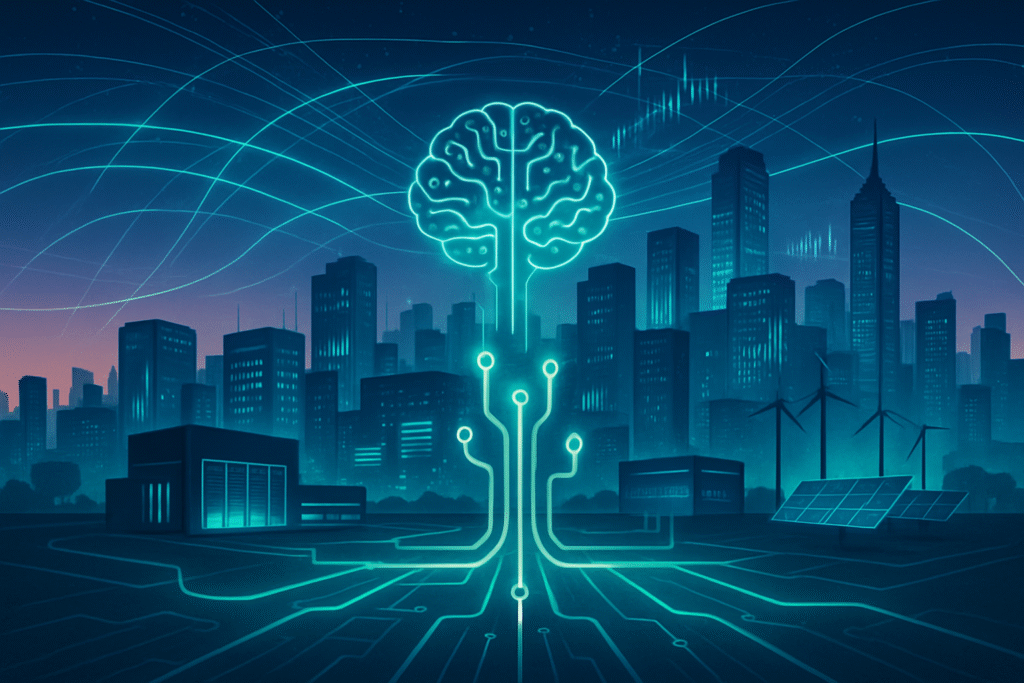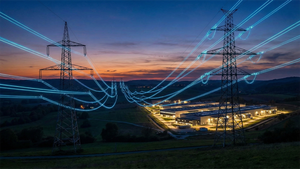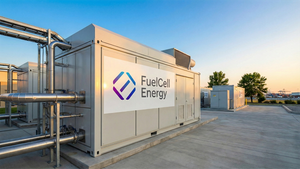
Artificial intelligence (AI) stands at the precipice of a profound transformation, fundamentally reshaping the global economy and placing unprecedented demands on our energy infrastructure. As of October 5, 2025, the immediate significance of AI's pervasive integration is evident across industries, driving productivity gains, revolutionizing operations, and creating new economic paradigms. However, this technological leap is not without its challenges, notably the escalating energy footprint of advanced AI systems, which is concurrently forcing a critical re-evaluation and modernization of global power grids.
The surge in AI applications, from generative models to sophisticated optimization algorithms, is projected to add trillions annually to the global economy, enhancing labor productivity by approximately one percentage point in the coming decade. Concurrently, AI is proving indispensable for modernizing power grids, enabling greater efficiency, reliability, and the seamless integration of renewable energy sources. Yet, the very technology promising these advancements is also consuming vast amounts of electricity, with data centers—the backbone of AI—projected to account for a significant and growing share of global power demand, posing a complex challenge that demands innovative solutions and strategic foresight.
The Technical Core: Unpacking Generative AI's Power and Its Price
The current wave of AI innovation is largely spearheaded by Large Language Models (LLMs) and generative AI, exemplified by models like OpenAI's GPT series, Google's Gemini, and Meta's Llama. These models, with billions to trillions of parameters, leverage the transformative Transformer architecture and its self-attention mechanisms to process and generate diverse content, from text to images and video. This multimodality represents a significant departure from previous AI approaches, which were often limited by computational power, smaller datasets, and sequential processing. The scale of modern AI, combined with its ability to exhibit "emergent abilities" – capabilities that spontaneously appear at certain scales – allows for unprecedented generalization and few-shot learning, enabling complex reasoning and creative tasks that were once the exclusive domain of human intelligence.
However, this computational prowess comes with a substantial energy cost. Training a frontier LLM like GPT-3, with 175 billion parameters, consumed an estimated 1,287 to 1,300 MWh of electricity, equivalent to the annual energy consumption of hundreds of U.S. homes, resulting in hundreds of metric tons of CO2 emissions. While training is a one-time intensive process, the "inference" phase – the continuous usage of these models – can contribute even more to the total energy footprint over a model's lifecycle. A single generative AI chatbot query, for instance, can consume 100 times more energy than a standard Google search. Furthermore, the immense heat generated by these powerful AI systems necessitates vast amounts of water for cooling data centers, with some models consuming hundreds of thousands of liters of clean water during training.
The AI research community is acutely aware of these environmental ramifications, leading to the emergence of the "Green AI" movement. This initiative prioritizes energy efficiency, transparency, and ecological responsibility in AI development. Researchers are actively developing energy-efficient AI algorithms, model compression techniques, and federated learning approaches to reduce computational waste. Organizations like the Green AI Institute and the Coalition for Environmentally Sustainable Artificial Intelligence are fostering collaboration to standardize measurement of AI's environmental impacts and promote sustainable solutions, aiming to mitigate the carbon footprint and water consumption associated with the rapid expansion of AI infrastructure.
Corporate Chessboard: AI's Impact on Tech Giants and Innovators
The escalating energy demands and computational intensity of advanced AI are reshaping the competitive landscape for tech giants, AI companies, and startups alike. Major players like Alphabet (NASDAQ: GOOGL), Microsoft (NASDAQ: MSFT), and Amazon (NASDAQ: AMZN), deeply invested in AI development and extensive data center infrastructure, face the dual challenge of meeting soaring AI demand while adhering to ambitious sustainability commitments. Microsoft, for example, has seen its greenhouse gas emissions rise due to data center expansion, while Google's emissions in 2023 were significantly higher than in 2019. These companies are responding by investing billions in renewable energy, developing more energy-efficient hardware, and exploring advanced cooling technologies like liquid cooling to maintain their leadership and mitigate environmental scrutiny.
For AI companies and startups, the energy footprint presents both a barrier and an opportunity. The skyrocketing cost of training frontier AI models, which can exceed tens to hundreds of millions of dollars (e.g., GPT-4's estimated $40 million technical cost), heavily favors well-funded entities. This raises concerns within the AI research community about the concentration of power and potential monopolization of frontier AI development. However, this environment also fosters innovation in "sustainable AI." Startups focusing on energy-efficient AI solutions, such as compact, low-power models or "right-sizing" AI for specific tasks, can carve out a competitive niche. The semiconductor industry, including giants like NVIDIA (NASDAQ: NVDA), Intel (NASDAQ: INTC), and TSMC (NYSE: TSM), is strategically positioned to benefit from the demand for energy-efficient chips, with companies prioritizing "green" silicon gaining a significant advantage in securing lucrative contracts.
The potential disruptions are multifaceted. Global power grids face increased strain, necessitating costly infrastructure upgrades that could be subsidized by local communities. Growing awareness of AI's environmental impact is likely to lead to stricter regulations and demands for transparency in energy and water usage from tech companies. Companies perceived as environmentally irresponsible risk reputational damage and a reluctance from talent and consumers to engage with their AI tools. Conversely, companies that proactively address AI's energy footprint stand to gain significant strategic advantages: reduced operational costs, enhanced reputation, market leadership in sustainability, and the ability to attract top talent. Ultimately, while energy efficiency is crucial, proprietary and scarce data remains a fundamental differentiator, creating a positive feedback loop that is difficult for competitors to replicate.
A New Epoch: Wider Significance and Lingering Concerns
AI's profound influence on the global economy and power grid positions it as a general-purpose technology (GPT), akin to the steam engine, electricity, and the internet. It is expected to contribute up to $15.7 trillion to global GDP by 2030, primarily through increased productivity, automation of routine tasks, and the creation of entirely new services and business models. From advanced manufacturing to personalized healthcare and financial services, AI is streamlining operations, reducing costs, and fostering unprecedented innovation. Its impact on the labor market is complex: while approximately 40% of global employment is exposed to AI, leading to potential job displacement in some sectors, it is also creating new roles in AI development, data analysis, and ethics, and augmenting existing jobs to boost human productivity. However, there are significant concerns that AI could exacerbate wealth inequality, disproportionately benefiting investors and those in control of AI technology, particularly in advanced economies.
On the power grid, AI is the linchpin of the "smart grid" revolution. It enables real-time optimization of energy distribution, advanced demand forecasting, and seamless integration of intermittent renewable energy sources like solar and wind. AI-driven predictive maintenance prevents outages, while "self-healing" grid capabilities autonomously reconfigure networks to minimize downtime. These advancements are critical for meeting increasing energy demand and transitioning to a more sustainable energy future.
However, the wider adoption of AI introduces significant concerns. Environmentally, the massive energy consumption of AI data centers, projected to reach 20% of global electricity use by 2030-2035, and their substantial water demands for cooling, pose a direct threat to climate goals and local resource availability. Ethically, concerns abound regarding job displacement, potential exacerbation of economic inequality, and the propagation of biases embedded in training data, leading to discriminatory outcomes. The "black box" nature of some AI algorithms also raises questions of transparency and accountability. Geopolitically, AI presents dual-use risks: while it can bolster cybersecurity for critical infrastructure, it also introduces new vulnerabilities, making power grids susceptible to sophisticated cyberattacks. The strategic importance of AI also fuels a potential "AI arms race," leading to power imbalances and increased global competition for resources and technological dominance.
The Horizon: Future Developments and Looming Challenges
In the near term, AI will continue to drive productivity gains across the global economy, automating routine tasks and assisting human workers. Experts predict a "slow-burn" productivity boost, with the main impact expected in the late 2020s and 2030s, potentially adding trillions to global GDP. For the power grid, the focus will be on transforming traditional infrastructure into highly optimized smart grids capable of real-time load balancing, precise demand forecasting, and robust management of renewable energy integration. AI will become the "intelligent agent" for these systems, ensuring stability and efficiency.
Looking further ahead, the long-term impact of AI on the economy is anticipated to be profound, with half of today's work activities potentially automated between 2030 and 2060. This will lead to sustained labor productivity growth and a permanent increase in economic activity, as AI acts as an "invention in the method of invention," accelerating scientific progress and reducing research costs. AI is also expected to enable carbon-neutral enterprises between 2030 and 2040 by optimizing resource use and reducing waste across industries. However, the relentless growth of AI data centers will continue to escalate electricity demand, necessitating substantial grid upgrades and new generation infrastructure globally, including diverse energy sources like renewables and nuclear.
Potential applications and use cases are vast. Economically, AI will enhance predictive analytics for macroeconomic forecasting, revolutionize financial services with algorithmic trading and fraud detection, optimize supply chains, personalize customer experiences, and provide deeper market insights. For the power grid, AI will be central to advanced smart grid management, optimizing energy storage, enabling predictive maintenance, and facilitating demand-side management to reduce peak loads. However, significant challenges remain. Economically, job displacement and exacerbated inequality require proactive reskilling initiatives and robust social safety nets. Ethical concerns around bias, privacy, and accountability demand transparent AI systems and strong regulatory frameworks. For the power grid, aging infrastructure, the immense strain from AI data centers, and sophisticated cybersecurity risks pose critical hurdles that require massive investments and innovative solutions. Experts generally hold an optimistic view, predicting continued productivity growth, the eventual development of Artificial General Intelligence (AGI) within decades, and an increasing integration of AI into all aspects of life.
A Defining Moment: Charting AI's Trajectory
The current era marks a defining moment in AI history. Unlike previous technological revolutions, AI's impact on both the global economy and the power grid is pervasive, rapid, and deeply intertwined. Its ability to automate cognitive tasks, generate creative content, and optimize complex systems at an unprecedented scale solidifies its position as a primary driver of global transformation. The key takeaways are clear: AI promises immense economic growth and efficiencies, while simultaneously presenting a formidable challenge to our energy infrastructure. The balance between AI's soaring energy demands and its potential to optimize energy systems and accelerate the clean energy transition will largely determine its long-term environmental footprint.
In the coming weeks and months, several critical areas warrant close attention. The pace and scale of investments in AI infrastructure, particularly new data centers and associated power generation projects, will be a key indicator. Watch for policy and regulatory responses from governments and international bodies, such as the IEA's Global Observatory on AI and Energy and UNEP's forthcoming guidelines on energy-efficient data centers, aimed at ensuring sustainable AI development and grid modernization. Progress in upgrading aging grid infrastructure and the integration of AI-powered smart grid technologies will be crucial. Furthermore, monitoring labor market adjustments and the effectiveness of skill development initiatives will be essential to manage the societal impact of AI-driven automation. Finally, observe the ongoing interplay between efficiency gains in AI models and the potential "rebound effect" of increased usage, as this dynamic will ultimately shape AI's net energy consumption and its broader geopolitical and energy security implications.
This content is intended for informational purposes only and represents analysis of current AI developments.
TokenRing AI delivers enterprise-grade solutions for multi-agent AI workflow orchestration, AI-powered development tools, and seamless remote collaboration platforms.
For more information, visit https://www.tokenring.ai/.




